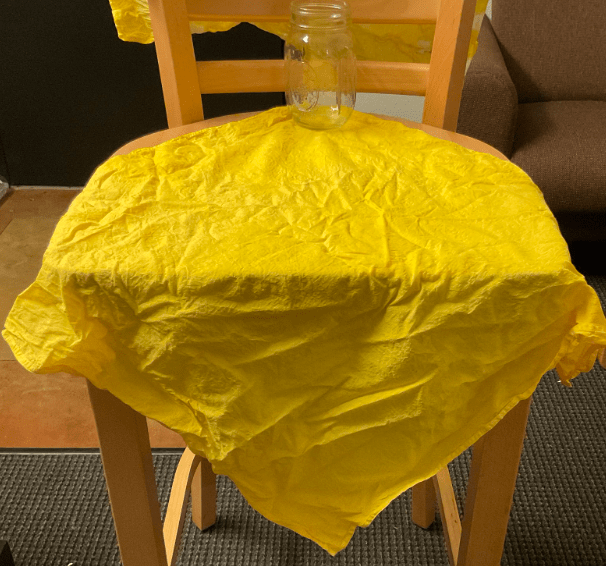Note: In Spring 2022, UC Santa Cruz students had an opportunity to participate in a virtual “Making with Marigold” workshop hosted by the Black Botany Studio and guided by visiting guest artist scholar Jennifer Steverson. In this post, one of the student participants (Ethan) reflects on his workshop experience.
____________________________________________________________________________________________

by Ethan D.
As a Afro-Latinx-Caribbean male living in California, it can be difficult to be in touch with my ancestral roots. This is the product of multiple factors, that being geographic isolation from my family in the Caribbean, and the highly concentration of Caribbean people being in the East Coast (New York, Massachusetts, etc.). In addition, because of COVID and lack of vaccine availability in the Caribbean, my usual pilgrimages to my extended family have ceased along with my yearly trips to see my grandparents in Grenada.
I remember my grandma telling me stories about her life growing up as well as folk tales and ancestral history, but what interested me the most in this context was the use of natural resources, especially squid ink for writing. Though today I do not use much botanical medicine in my life, save for making sure to eat healthy, I still have the love for plants my grandmother instilled in my mom, and of which she instilled in me. I have 10 plants I take care of, and teach many of the folks around me who have an interest how to transplant plants, general care and maintenance These plants include: Pothos, Snake plant, Plumosa fern, and a selection of succulents. I am proud of my knowledge, but what I always try to center is that I, like the people I assist are still learning. Anytime I go to my local nursery, I try to come to that place in the energy of a student absorbing what I learn, and through that I can become a better carer of plants. Overconfidence and pride can only close oneself from knowledge.
What was enlightening and welcoming about the Making with Marigold Workshop was how welcoming the space was and how every culture, yet different, has ways of dyeing fabric. Some of my favorite parts of the workshop is the background given at each step. Examples include the use of mordanting, and Ms. Steverson’s background and introduction to dyeing. She did not have to do this, but teacher who talk of how they learned what they are teaching make the material more accessible and real, and that is the exact feeling I had when learning. A feeling of nervousness and wonder at this natural dye and the final product.
Having this workshop felt collaborative in more than the directions given, but the context we were in. In the Black Botanical Medicine in the Americas course (SOCY 143), those with an interest take the class, and each identity of folks that comes in can be traced back to many differing parts of the world. Having a focus on Blackness is revolutionary to the many common ways botanical medicine is taught. Many practices and knowledge often is not attributed to Africa or the people in the African Diaspora, which can be confusing to even consider that the cradle of humanity did not have any advancements that we do not use. For example, any and all biomedicine can be traced back to botanical medicine, as biomedicine is botanical research in a Western medicinal view. Yet even that view discredits the work done first in Africa, and spread to other continents, and their own areas of academic, botanical, and biomedicine those cultures have created. Many of the first universities were not of European origin, but of African origin, including areas in Egypt, Mali, and Morocco (for example Barnes 2022).
What I also appreciated about the marigolds was that it brought up my memory of shared practices in the Caribbean with multiple ethnic groups. As an Afro-Latinx-Caribbean with ancestry from Grenada, Cuba, and Jamaica, it is interesting to see the commonalities between cultures. As many cultures do use Marigolds, in the same way do many cultures in the Caribbean utilize tamarind, mango, and of course jamaica and sorrel. My Dad, who is Jamaican and Cuban, would often create different Caribbean drinks and food to keep us near to the culture, and sorrel was one beverage I remember him making with excitement and telling us the history of it. In the way that this workshop reinforced my blackness, it also made me aware of intersection and commonalities between cultures.
Works Cited:
Mo Barnes. “Black history month: The oldest university in the world is in Africa.” (2019, February 9). Rolling Out. Retrieved June 9, 2022, from https://rollingout.com/2019/02/09/black-history-month-the-oldest-university-in-the-world-is-in-africa/
____________________________________________________________________________________________
Ethan D. is a Molecular, Cell, and Developmental Biology Major B.S. and Black Studies minor (University of California Santa Cruz ‘23). I am from Riverside, CA and have interests in history, plants, hiking, and learning music, specifically guitar and vocals. My hope is to attend law school after a gap year with an interest in copyright and intellectual property law.
____________________________________________________________________________________________